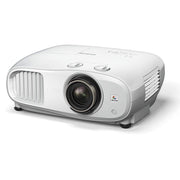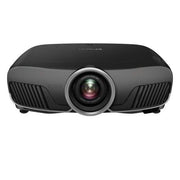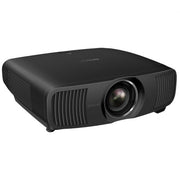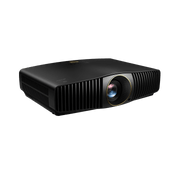The use of projectors in home theatres and office spaces has quickly become a very popular setup. If you’re considering designing your own home theatre room, or upgrading your current space, you’ve likely thought about purchasing a projector—and why wouldn’t you? They offer an excellent viewing experience, come with a range of advanced features and are very versatile.
However, with such a huge range of projectors on the market, it can be difficult to know what kind will suit your needs. If you’re thinking about upgrading your space with a projector, you may be wondering, what is a short throw projector? How does a projector work? What are the key technical specifications I should know about? These are important questions that we are here to answer for you.
Types of projectors
Despite the increased popularity of projectors, there is still some confusion about how each type differs from each other. Here’s our breakdown.
Home theatre projectors
Home theatre projectors are able to play fast moving video smoothly, without delay. This makes them suitable for movies and gaming, and a popular choice in many peoples’ home theatre setup—in your research you would have likely come across these.
Plus, if your room’s foot traffic is closer to the big screen, a long throw home theatre projector is a good choice to avoid any shadows interrupting the projection.

Epson EH-TW7100 4K PRO-UHD Home Theatre Projector

Epson EH-TW9400 4K PRO-UHD Home Theatre Projector

Epson EH-LS12000 Pro-Cinema 4K UHD Projector

BenQ W5800 4K Laser Home Theatre Projector
Data projectors
Data projectors are best for static images. They are great for educational purposes, this is why they are often used in workplaces or places of learning. They are designed to be portable and lightweight so they are easy to move from place to place as the need arises.
Short-throw projectors
Now, you may be asking: exactly what is a short throw projector and how does it differ? This is a great piece of equipment if you want the full impact image a projector can provide but only have a small space to work with. Short throw projectors have a lens that is able to create a large picture from a shorter distance, so they usually only need to be placed a few feet from the screen.
They are also portable and lightweight, so they are great for situations where a projector is needed in multiple rooms or you’d like to take your movie night outdoors.
Ultra-short throw projectors
Working similarly to short throw projectors, ultra short throw projectors have a lens that can create a large image from a much smaller distance, usually just a few inches from the screen.
These are starting to become quite popular and are seen as an alternative to a large screen TV in living room environments which are somewhat light controlled from direct sunlight. To get the best performance out of these types of projectors, you use a special UST screen material— sometimes referred to as CLR (Ceiling Light Rejecting). These allow for better performance with some ambient light in the room, and cut down on the light bouncing off the screen onto the ceiling due to the sharp projection angle.
There are a couple of limitations to Ultra Short Throw Projectors which people don’t always mention. The dedicated UST screens generally only go up to 120” screen size. Also, the projector screen needs to be perfectly flat, as due to the sharp projection angle the image can be distorted when the screen isn’t perfectly flat, especially at the top of the image. You also can not use these with acoustically transparent projector screens, so are not recommended for dedicated home cinemas.
Projector components: how does a projector work?
If you've caught yourself wondering 'how does a projector work, really?' you're not alone. Projection technology can seem complex but essentially it works by taking a beam of light and turning it into a movie, game or other piece of visual media. LCD and DLP projectors are two of the most common projector types and function in two different ways to achieve the projection of an image.
LCD projectors, or liquid crystal display projectors, work by shining a light through three LCD panels for each primary colour, which creates an image that is then ‘projected’ through the lens onto a projector screen.
DLP, or digital light processing, projectors are differentiated by the DLP chip which was developed by Texas Instruments. These digital projectors work by beaming light through a colour wheel, reflection mirrors and then a projection lens. This creates pulsating shades of red, blue, then green light beams alternating so quickly that our brains put together a complete final image.
Key technical specifications
Modern projectors have lots of technical specifications that alter the way the image looks on the screen. The three key specifications you should familiarise yourself with are resolution, brightness and contrast.
Resolution
Resolution determines how clear the projected image will be based on how many pixels can be displayed on the screen. Higher resolution means there are more pixels to make up a clearer, crisper image. This is important for projecting detailed charts, text and high-definition video.
Brightness
During your browsing of the huge range of projectors on offer, you may have noticed that projector brightness is measured in lumens.
Standardly, projectors that will be used in dark rooms like home theatres where ambient light is at a minimum can get away with fewer lumens, at least 1500 lumens. Larger screen sizes will also require higher lumens projectors to ensure sufficient onscreen brightness. Whereas if your projector will be used in a classroom, for example, or space where the bright light source is harder to shut out, you will require upwards of 2500 lumens. Generally, if you want brighter images, rooms that are exposed to more ambient light will benefit from a projector with high brightness.
Contrast
Contrast ratio is the difference between how much brighter the white parts of the image are compared to the dark on the screen. The higher the contrast ratio, the more detail you can see on the projected image. Contrast makes it possible for us to see the subtler shades of colour too, creating a richer image.
How a projector will benefit your setup
Both moderately priced and high-end projectors are fast becoming the new norm in home theatres and workplaces that require portability—and it's no surprise why. The benefits projectors can offer include:
- Customisable screen size
- Huge images
- Value for money
- Saving on space
- Images that are more comfortable to the human eye that the emitted light of TVs
- Easy installation
Plus, they offer you customisation of the look of your image and they come with some great preset specifications to get you started.
Ready for your new projector?
Now that you know the answer to the question 'how does a projector work?' and you have all you need to know about the newest addition to your hi-fi setup, shop the highest quality range of projectors at CHT Solutions today.
If you need any further advice, reach out to our friendly team for our professional recommendation on which is best for your unique setup.







